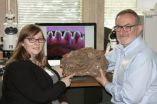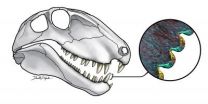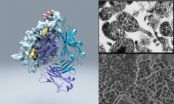(Press-News.org) The first top predators to walk on land were not afraid to bite off more than they could chew, a University of Toronto Mississauga study has found.
Graduate student and lead author Kirstin Brink along with Professor Robert Reisz from U of T Mississauga's Department of Biology suggest that Dimetrodon, a carnivore that walked on land between 298 million and 272 million years ago, was the first terrestrial vertebrate to develop serrated ziphodont teeth.
According to the study published in Nature Communications, ziphodont teeth, with their serrated edges, produced a more-efficient bite and would have allowed Dimetrodon to eat prey much larger than itself.
While most meat-eating dinosaurs possessed ziphodont teeth, fossil evidence suggests serrated teeth first evolved in Dimetrodon some 40 million years earlier than theropod dinosaurs.
"Technologies such as scanning electron microscope (SEM) and histology allowed us to examine these teeth in detail to reveal previously unknown patterns in the evolutionary history of Dimetrodon," Brink said.
The four-meter-long Dimetrodon was the top of the terrestrial food chain in the Early Permian Period and is considered to be the forerunner of mammals.
According to Brink and Reisz's research, Dimetrodon had a diversity of previously unknown tooth structures and were also the first terrestrial vertebrate to develop cusps – teeth with raised points on the crown, which are dominant in mammals.
The study also suggests ziphodont teeth were confined to later species of Dimetrodon, indicating a gradual change in feeding habits.
"This research is an important step in reconstructing the structure of ancient complex communities," Reisz said.
"Teeth tell us a lot more about the ecology of animals than just looking at the skeleton."
"We already know from fossil evidence which animals existed at that time but now with this type of research we are starting to piece together how the members of these communities interacted."
Brink and Reisz studied the changes in Dimetrodon teeth across 25 million years of evolution.
The analysis indicated the changes in tooth structure occurred in the absence of any significant evolution in skull morphology. This, Brink and Reisz suggest, indicates a change in feeding style and trophic interactions.
"The steak knife configuration of these teeth and the architecture of the skull suggest Dimetrodon was able to grab and rip and dismember large prey," Reisz said.
"Teeth fossils have attracted a lot of attention in dinosaurs but much less is known about the animals that lived during this first chapter in terrestrial evolution."
INFORMATION:
The study was funded by a Natural Sciences and Engineering Research Council (NSERC) postgraduate scholarship to Kirstin Brink and an NSERC Discovery Grant to Robert Reisz.
MEDIA CONTACTS
Kirstin Brink
Department of Biology
University of Toronto Mississauga
905-828-3982
647-981-1749
kirstin.brink@mail.utoronto.ca
Professor Robert Reisz
Department of Biology
University of Toronto Mississauga
905-828-3981
647-830-5364
Gareth Trickey
U of T Mississauga Communications
905-828-3983
nicolle.wahl@utoronto.ca
'Steak-knife' teeth reveal ecology of oldest land predators
2014-02-07
ELSE PRESS RELEASES FROM THIS DATE:
Study reveals record rise in insulin use
2014-02-07
"Understanding the pattern of insulin use is limited by a lack of data characterising the prevalence of insulin use in the UK," according to Craig Currie, Professor of Applied Pharmacoepidemiology at Cardiff University's School of Medicine, who led the study alongside colleagues from the University of Bristol.
"Given the limitations, our study sought to calculate – for the first time – the best possible estimate of the rates of insulin for type 1 and type 2 diabetes."
In this retrospective study the team examined the number of patients receiving prescriptions for ...
Rett syndrome genetic variants now available for advance testing, diagnosis & research
2014-02-07
Philadelphia, PA, February 7, 2014 – Despite the identification of gene mutations in methyl CpG binding protein 2 (MECP2) being linked to Rett syndrome (RS), research has been hindered by the lack of commercially available reference materials. Through collaboration between the Centers for Disease Control and Prevention (CDC) and members of the clinical-laboratory and non-profit–research communities, 35 DNA samples containing many common RS genetic variants have now been characterized and made publicly available, eliminating a major stumbling-block for investigators and ...
New guidelines for reducing stroke risks unique to women
2014-02-06
For the first time, guidelines have been developed for preventing stroke in women.
"If you are a woman, you share many of the same risk factors for stroke with men, but your risk is also influenced by hormones, reproductive health, pregnancy, childbirth and other sex-related factors," said Cheryl Bushnell, M.D., M.H.S., author of the new scientific statement published in the American Heart Association journal Stroke.
The guidelines outline stroke risks unique to women and provide scientifically-based recommendations on how best to treat them, including:
Women with a ...
Cholesterol plays a critical role in hantavirus infection
2014-02-06
Viruses mutate fast, which means they can quickly become resistant to anti-viral drugs. But viruses also depend on proteins and nutrients provided by their hosts, and therefore one strategy to identify new anti-viral drugs is to identify and target such host-cell components. A paper published on February 6th in PLOS Pathogens reports that proteins involved in the regulation of cholesterol are essential for hantavirus entry into human host cells.
There are only about 30 known human cases of hantavirus infection in the US per year (with the 2012 cluster in Yosemite National ...
Toxin in seafood causes kidney damage in mice at levels considered safe for consumption
2014-02-06
Washington, DC (February 6, 2014) — A chemical that can accumulate in seafood and is known to cause brain damage is also toxic to the kidneys, but at much lower concentrations. The findings, which come from a study appearing in an upcoming issue of the Journal of the American Society of Nephrology (JASN), suggest that officials may need to reconsider what levels of the toxin are safe for human consumption.
The world's oceans contain algae that produce certain chemicals that can be harmful to humans and other living creatures. Many of these chemicals are considered neurotoxins ...
Acute kidney injury may be a risk factor for later heart problems
2014-02-06
Washington, DC (February 6, 2014) — Patients who experience abrupt kidney injury following surgery have an increased risk of later developing heart problems, according to a study appearing in an upcoming issue of the Journal of the American Society of Nephrology (JASN). The findings suggest that properly treating and monitoring patients with acute kidney injury (AKI) could help protect their heart health.
AKI, an sudden decline in kidney function, is an increasingly prevalent and potentially serious condition in hospitalized patients. Sometimes acute kidney injury arises ...
Reduce the chloride to restore the switch
2014-02-06
This news release is available in French. A drug given to pregnant mice with models of autism prevents autistic behavior in their offspring, a new report shows, and though the drug could not be administered prenatally in humans (there is no way to screen for autism in human fetuses), clinical trials of this drug administered later in development, in young children who have already developed autistic symptoms, are showing progress.
The causes of autism spectrum disorder, or ASD, are complex and not well understood.
Prolonged excitation of brain neurons seems partly ...
The ultimate decoy: Scientists find protein that helps bacteria misdirect immune system
2014-02-06
LA JOLLA, CA—February 6, 2014—A team led by scientists at The Scripps Research Institute (TSRI) has discovered an unusual bacterial protein that attaches to virtually any antibody and prevents it from binding to its target. Protein M, as it is called, probably helps some bacteria evade the immune response and establish long-term infections.
If follow-up studies confirm Protein M's ability to defeat the antibody response, it is likely to become a target of new antibacterial therapies. The protein's unique ability to bind generally to antibodies also should make it a valuable ...
Decoding dengue and West Nile: Researchers take steps toward control of health proble
2014-02-06
ANN ARBOR—Dengue fever and West Nile fever are mosquito-borne diseases that affect hundreds of millions of people worldwide each year, but there is no vaccine against either of the related viruses.
A team of scientists at the University of Michigan and Purdue University has discovered a key aspect both to how the viruses replicate in the cells of their host and how they manipulate the immune system as they spread.
In a study scheduled for online publication Feb. 6 in the journal Science, researchers led by Janet Smith of the U-M Life Sciences Institute describe for ...
Autism: Birth hormone may control the expression of the syndrome in animals
2014-02-06
This news release is available in French.
The scientific community agrees that autism has its origins in early life—foetal and/or postnatal. The team led by Yehezkel Ben-Ari, Inserm Emeritus Research Director at the Mediterranean Institute of Neurobiology (INMED), has made a breakthrough in the understanding of the disorder. In an article published in Science, the researchers demonstrate that chloride levels are elevated in the neurons of mice used in an animal model of autism, and remain at abnormal levels from birth. These results corroborate the success obtained ...




